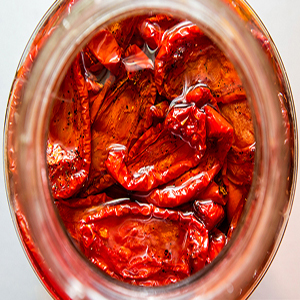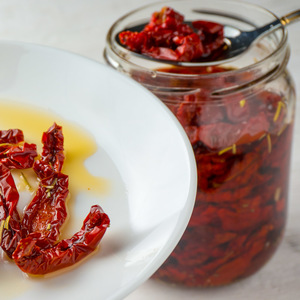How to cook dried peppers for the winter: recipes with photos, tips for storing the workpiece
Sun-dried tomatoes in oil are an exquisite appetizer that has conquered many with its excellent taste and aroma of herbs. Did you know that Bulgarian and hot peppers are harvested by the same method? Today we will tell you about the secrets and benefits of making dried peppers at home.
The content of the article
Harvesting dried peppers for the winter
 Drying is one of the best ways to preserve perishable vegetables for the winter. These include Bulgarian and burning pepper. The method is based on the principle of partial moisture evaporation. The result is elastic slices that, when pressed, bend rather than crumble into dust.
Drying is one of the best ways to preserve perishable vegetables for the winter. These include Bulgarian and burning pepper. The method is based on the principle of partial moisture evaporation. The result is elastic slices that, when pressed, bend rather than crumble into dust.
In this matter, it is important to choose quality products and prepare them correctly. Household appliances are used for drying: a microwave oven, an oven, an electric dryer.
The finished product is perfectly stored in oil filling in the refrigerator or in glass containers without additives.
Bulgarian
To prepare delicious dried peppers, use the tips for choosing and preparing fruits:
- Buy vegetables with bright colors and thick flesh. They should be free of signs of rot, stains and cracks.
- Rinse the fruit in warm water and pat dry with a paper towel. Cut the large ones into quarters, the middle ones in half. Remove tails and seed pods. Sometimes peppers are peeled to add flavor. But this is not a mandatory rule. Cook as you wish.
- To remove the skin, pour boiling water over the fruits and leave for three minutes. Then transfer to cold water. Use a knife to pick up the peel and peel it off with a quick motion.
- Before starting the drying process, brush the peppers with vegetable oil, sprinkle with spices and chopped garlic. Add some sea salt or sugar. This will enhance the taste of the product.
Acute
The rules for preparing hot peppers are no different from the preparation of sweet fruits:
- Choose peppercorns with thick flesh and a smooth, firm surface.
- Wash the fruits, dry and cut into halves. Cut off the stem and remove the seeds. Rinse the slices under running water, remove the inner membranes. If you want to keep the pungency, leave some of the seeds.
- Put the peppers on a baking sheet, pour oil as desired and sprinkle with spices, dry herbs.
Advantages and disadvantages of the method
The main advantage of dried peppers is the ability to retain most of the vitamins and minerals needed to maintain immunity during the cold season. Compared to dried peppers, the taste of dried peppers is brighter and richer.
With regular use of the product, the condition of the hair and nails improves. A large amount of fiber normalizes the functioning of the intestines, and, consequently, other interconnected body systems.
Potassium and magnesium regulate the work of the heart and blood vessels, prevent blood clots, and promote blood thinning. Pepper has a beneficial effect on the condition of the mucous membranes and skin.
The calorie content of dried peppers without additives in the form of vegetable oil and spices is 118 kcal per 100 g.
There is no need to talk about the disadvantages of dried peppers. Here are some solid pluses:
- not too time consuming;
- stored dry for a long time and even longer in oil filling;
- the product does not lose its taste and is able to enrich dishes from cereals, meat, flour and other vegetables.
How to cook dried peppers
 Household appliances are used to prepare dried peppers: a microwave oven, an oven and an electric dryer. Each of their methods has advantages and disadvantages. Let's talk about them in more detail.
Household appliances are used to prepare dried peppers: a microwave oven, an oven and an electric dryer. Each of their methods has advantages and disadvantages. Let's talk about them in more detail.
In the oven
Modern ovens are equipped with many useful features. One of them is convection, which allows you to dry any fruits and vegetables without much effort.
The mode provides free air circulation inside. This allows excess moisture to evaporate quickly. If you have an older model of oven, just keep the door ajar.
Preparation:
- Prepare the peppers, line the baking sheet with baking paper.
- Spread the pieces upside down. Inside the boats, you can put garlic, spices and pour oil.
- Set the temperature to 100-120 ° C and leave for 1.5 hours.
- Turn off the oven, leave to cool for a while, then set the same temperature and cook for 40-60 minutes.
- Leave in the oven until it cools completely.
In the dryer
Drying peppers in an electric dryer is as easy as shelling pears:
- Put the prepared vegetables on the wire racks, leaving space between the slices.
- Set the temperature to 75 ° C. Check vegetables every 30 minutes and turn if necessary. Remember, the peppers don't need to dry out completely.
- The preparation time of the workpiece is 3-4 hours.
In the microwave
Microwaving dried peppers is the hardest part of the day. It is necessary to constantly be on the alert and monitor vegetables. The main task is to prevent vegetables from being cooked.
Preparation:
- Put prepared vegetables on a plate, pour with oil.
- Set the maximum power and cooking time to 5 minutes. Then take out the plate, drain the resulting liquid.
- Cool the slices and repeat the process 3-4 times. Remember to drain the juice every time.
How to check readiness
Wrinkled skin indicates readiness of the product. In this case, the pulp will decrease several times. The pieces are elastic to the touch, dried, but not excessively dry. A small percentage of moisture should remain in the pepper.
How to store dried peppers
Dried peppers in dry form are perfectly preserved in glass containers with lids. But most often, the slices are poured with the fragrant oil in which they were prepared, or they are prepared on its basis with the addition of spices.
Any vegetable oil is suitable - olive or sunflower. It should completely cover the vegetables and be two centimeters higher than their level.
Peppers in oil are stored in the refrigerator or in a cool dark place.
Dried peppers for the winter in oil
To cook jerky peppers in oil, use a simple recipe (pictured - finished result).
Ingredients:
- Bulgarian or hot pepper - 1 kg;
- extra virgin olive oil - 50 ml;
- balsamic vinegar to taste.
Preparation:
- Wash the peppers, dry them, remove the stalk and core. Rinse with cold water and place in a bowl, cut side down. This will ensure the free flow of water.
- Cover the baking sheet with parchment or grease with oil. Arrange the slices.
- Preheat oven to 120 ° C, place baking sheets and cook for 3-4 hours. Reduce heat gradually to 110 ° C.
- Remove vegetables after cooking time and leave to cool.
- Heat vegetable oil in a water bath or microwave. Add garlic if desired.
- Place the peppers in a jar, cover with warm oil, pour in some balsamic vinegar and close the lid.
reference... Vinegar extends the shelf life of the workpiece.
Store in the refrigerator or cellar.
In seasonings and spices
Dried peppers in fragrant herbs and spices will delight you with their rich taste and pleasant aroma.
Ingredients:
- sweet or hot pepper - 1 kg;
- rosemary, thyme, oregano;
- salt, black pepper - to taste;
- Extra Virgin olive oil - 80 ml;
- garlic - 3-4 cloves.
Preparation:
- Wash vegetables, peel, rinse with water. Cut into 2-4 pieces, depending on the size.
- Cook in an oven at 100 ° C or in an electric dryer at 75 ° C.Adjust the time as you see fit and keep an eye on the slices to avoid overdrying.
- Peel the garlic and cut into slices thinly.
- Put chilled peppers in a glass container, add spices and garlic.
- Pour in the olive oil and cover.
Store in the refrigerator on the top shelf.
Read also:
How to salt hot peppers for the winter according to the best recipes from around the world.
Chef's Notes
Dried peppers are a delicious snack with a wonderful taste and aroma. It is consumed independently, added to salads, meat dishes, pizza, spread on croutons, combined with other vegetables and cheese. For blanks, choose undamaged vegetables without spots and rot.